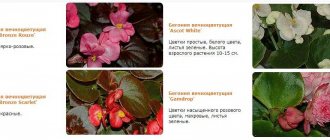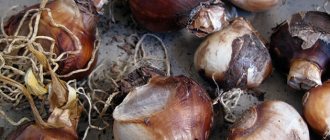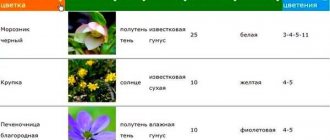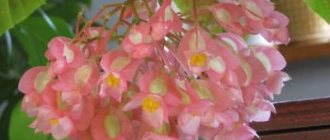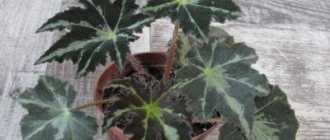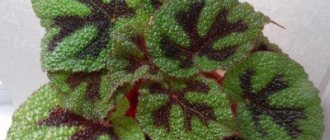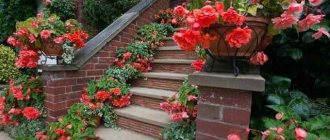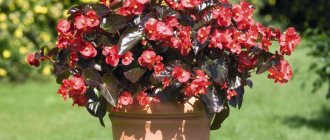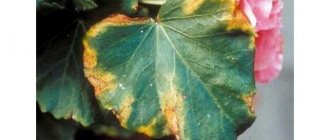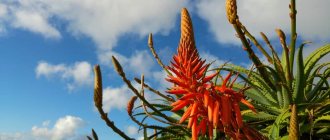- November 7, 2019
- Flowers
- Efimova Anastasia
Begonia is a well-known and widespread indoor plant. This genus has about 1000 species and countless varieties and hybrids. Begonias are surprisingly diverse in morphological characteristics. Among them you can find both large trees (up to 3 meters in indoor conditions and over 8 meters in a natural environment) and very tiny herbaceous plants - 10-15 cm tall.
Gardeners most often practice begonia propagation by stem cuttings and leaves (leaf cuttings). Other methods of growing seedlings are also used. The method most often depends on the type of begonia.
Popular varieties
There are several types of begonias that are grown everywhere:
- Royal, or rex. The most popular of the decorative deciduous trees. A plant with large (20x30 cm) heart-shaped leaves. They can be smooth or pubescent, and come in a variety of colors. Propagation of royal begonia by cuttings (stem and leaf) is possible. Popular varieties are Silver Greenheart (with silver leaves), Cartagena (dark, curled leaves, with pink or plum, silver spots), Hallelujah, Chocolate Cream, Evening Glow (with a crimson border on the leaves), Charm, November Cold, Black Fung ( leaves are red-black, with yellow veins twisted into a double spiral).
- Coral. A subshrub that, with good care at home, reaches one meter. The trunk is mostly bare, the leaves are large, oval, green, with whitish specks. The flowers are collected in elongated inflorescences of a beautiful coral color. Popular varieties - President Carnot, Lucerne.
- Ever-blooming. The most beautiful representative of the begonia genus. It is a low, 50-60 cm, bush with small leaves and flowers collected in large inflorescences. Flowers usually die quickly, but are immediately replaced by new ones. In this case, the cycle can continue for many months, and if good lighting is provided, the bushes will bloom in winter. Most often, ever-flowering begonia is propagated by cuttings. We'll tell you how to root it correctly a little later. Popular varieties are Amber, Carmen, Orange, Bikola, Fuchsividnaya.
- Elatir. A beautifully flowering ornamental plant without stems or shoots. At home, it is propagated mainly by leaves. Representatives - Louise, Rose, Renaissance.
- Ampelnaya. Varieties with creeping shoots and a wide variety of flowers - simple, double and semi-double. Propagation of ampelous begonia by cuttings is the most logical option. Other methods will be more labor intensive. Popular varieties are Christy, Gail, Katie, Roxana.
Planting young plants in a permanent pot
When replanting, be as careful as possible - begonia roots are very delicate. If you germinated the cuttings in the ground, transfer the plant without cleaning the root system.
For a young flower, you can buy ready-made soil “For begonias” or mix 2 parts of leaf soil and 1 part each of peat and black soil. And don't forget about drainage at the bottom of the pot!
Frequent fertilizing is not necessary. Maximum - twice a month, in spring and summer. Use complex mineral compositions for flowering crops, preferably not containing sulfur.
It is better not to transplant young plants directly into open ground. First, take the pot of begonia outside, place it in partial shade, allowing the flower to get used to the outdoor climate for several weeks.
In addition to our article, we invite you to watch this video instruction on propagating ever-flowering begonia from cuttings.
Reproduction methods
Begonias can be propagated by two main methods:
- Plant the seeds. This is a labor-intensive and time-consuming process; in addition, seed material will have to be purchased, since it is problematic to obtain it at home.
- Vegetative method: dividing tubers, rhizomes, layering, stem and leaf cuttings, leaf fragments. Most indoor begonias are propagated using the vegetative method. In this case, tuberous begonias are planted by dividing the tuber; the method of dividing the rhizome is suitable only for mature, overgrown bushes and varieties with a developed root system. Any species that has a central stem (apical cuttings) or shoots (lateral cuttings) can be propagated by cuttings. Only those types of begonias in which the leaf blade is thick, fleshy, with veins or has an edge are planted with leaves (leaf cuttings).
Home care
Lighting
Bright light is needed. The best lighting will be provided by windows facing east or southwest . On windows in northern directions, as well as during the season of short daylight hours, for “eternal flowering”, additional lighting is needed - so that the light period is 16 hours a day. On the south and south-east side, shading may be required - especially in high summer.
Temperature
The best temperature range throughout the year is from 20 to 25 degrees. How to preserve ever-blooming begonia in winter?
In winter, you need to protect the root system from hypothermia (for example, on a cold windowsill), and in summer , prevent overheating of the stems and leaves .
If begonia semperflorens is kept in winter with short daylight hours, you need to switch it to rest mode - keep it at a temperature of 12 to 15 degrees, but not lower: a temperature of +12ºС is critical for an initially tropical plant.
Priming
The plant does not have any special requirements for the soil substrate: it must be slightly acidic, sufficiently loose, nutritious, with good air and moisture permeability .
You can use ready-made soil for begonias , or garden soil with a good dose of perlite or vermiculite, and also prepare a mixture of equal parts of leaf soil, humus and sand.
Landing
The planting container may be wide rather than deep (plant roots develop in the surface layer of soil), with a mandatory drainage hole . Since stagnation of water is extremely unfavorable, it is better to choose a porous container material - ceramics without a continuous layer of glaze .
A drainage layer must be placed at the bottom of the container , then soil is poured into a small mound, on top of which a predominantly horizontal root system is placed and the soil mixture is added to the required level, gradually compacting it.
In one container you can plant several plants quite close to each other - with a minimum feeding area of 10x10 cm for each.
Transfer
Replant as they grow : young specimens more often, mature specimens less frequently, up to the point of replacing the replanting with a partial renewal of the surface layer of soil in the pot. In this case, as a rule, old plants lose their decorative properties and are replaced by young ones grown from cuttings.
Watering
Water moderately, mainly in the morning or evening. The main goal in this case is to prevent the soil and root system from drying out, or stagnation of moisture in the soil.
Between watering with soft, not cold water, the soil should dry out a little.
If in winter this begonia is in a dormant period, at a temperature of 12-15 degrees and short daylight hours , the frequency of watering should be reduced .
Air humidity
It is necessary to maintain an atmosphere of high humidity , similar to the “native” tropics, but direct spraying of the bush does not benefit either the leaves or flowers: dark spots appear on them.
You should spray water around the begonia , or place wide vessels with water nearby, and place the pot on a tray with moistened pebbles.
Top dressing
Feed the plant once a month with a weak solution of mineral fertilizers with a slightly reduced nitrogen component. Potassium and phosphorus, necessary for flowering plants, must be present in full.
If the wintering of the ever-flowering begonia is warm and light , do not stop .
Growth and pruning
This species does not grow higher than 40cm, but pruning - mainly after wintering - is carried out : excessively elongated shoots are shortened, weak ones are removed.
When pruning in spring, you can also prepare cuttings for vegetative propagation.
Bloom
Potentially, “semperflorence” is really capable of always blooming, with all the tropical forces showing new and new, double and simple, inflorescences of diverse shades, combinations and transitions: from white and soft cream to ultra-dark red (read about double varieties here).
The main guarantee of such a wonderful phenomenon is constant light, moderate heat and moisture - both in the soil and in the air.
Wilted inflorescences, like dried leaves, should be removed in a timely manner.
Preparation of planting material
How to properly plant a begonia cutting? Initially, it is necessary to select good planting material. Cuttings can be taken from the top of the bush or from side shoots. Usually it is possible to collect a lot of planting material when pruning a bush. Begonias are considered very tenacious, so for rooting they actually need only one growth point (leaf or bud on a branch). But it’s better if there are 3-4 of them. Therefore, cuttings are made 15-20 cm long, with an oblique cut at the bottom. The bottom leaf is cut off completely, a third is cut off from the top ones so that the leaf plates do not absorb a lot of vital juices.
For leaf cuttings, select leaves that are strong, without signs of disease, yellowing, or wilting, with developed veins.
There are two main ways to root begonia from cuttings - in water or soil. They are considered to be equivalent. But when planting in water, cuttings need to be prepared with a reserve, since some will certainly be lost. In addition, there is an opinion that when planted directly into the ground, healthier and stronger plants are obtained.
General rules for cuttings
There are several ways to propagate begonias from cuttings that give good results:
- stem cuttings;
- leaf cuttings;
- leaf fragments;
- division of tubers (in tuberous plants).
Most often, vegetative propagation by parts of the stem is used. This method is simple, and the survival rate of plant material is quite high.
For complete rooting, it is important not only to follow the step-by-step instructions when cutting cuttings, but also to take into account some additional features.
To increase the survival rate of plant material, experienced gardeners advise taking into account external conditions and following the general rules for rooting cuttings:
- Cutting time. From begonias growing in a room on a window, it is better to take cuttings for rooting in March. Planting in spring follows the natural biorhythm, so the plant will develop well and will soon delight you with lush flowers. You can take cuttings from begonias growing in open ground in the summer.
- Temperature conditions. The optimal temperature for rooting and subsequent growth is 20-25°C. If it is cold or very hot, then begonia cuttings do not take root well.
- Humidity. The taken shoot requires high humidity, so you need to make a mini-greenhouse from a plastic bag or a cut-off plastic bottle, making sure that parts of the plant do not touch the walls of the improvised greenhouse.
- Ventilation. Rooting begonia needs an influx of fresh air, so when growing in a greenhouse, the shelter must be periodically removed for a short time.
- Priming. To ensure the full development of young roots, the prepared soil mixture must be air- and moisture-permeable. A mixture of peat and sand or perlite is suitable.
- Pot volume. To plant begonia cuttings, a large container is not needed; cuttings are carried out in small pots or plastic cups, where the flower will remain until it is completely rooted. After the plant has taken root and began to grow, it is transplanted into a large container.
- Lighting. Light plays an important role for successful flower propagation. During rooting, begonia should be kept in a well-lit place.
- Choice of material. When propagating, it is necessary to select only healthy parts of the flower. Sick or weakened shoots do not take root well.
By following the suggested recommendations, you will be able to successfully propagate begonias by cuttings. You need to choose a method convenient for propagation (in water or in soil) and follow step-by-step instructions taking into account the chosen method.
Rooting in water
Before rooting begonia in water, you need to add a few drops of “Kornevin” or a similar phytostimulant. Then the container should be placed in a well-lit place, but not in direct sunlight, and wait 2-6 weeks. Once a week, the cuttings should be inspected for rot, and if it is found, they should be thrown out or trimmed.
As water evaporates, add water. As soon as the first roots appear, you should not delay replanting. The later young begonias go to permanent places, the longer they will adapt to new conditions.
General characteristics of evergreen begonia
This plant reaches 30 cm in length. The smooth bare stem includes 11 - 13 internodes (segments). On the first 4–5 of them leaves grow, on the remaining 7–8 flowers develop. The leaves are finely toothed, petiolate, asymmetrical. The color of the petals can range from white to bright red. There is a simple or terry corolla shape.
Various varieties of evergreen begonia
Begonia evergreen belongs to the genus Begonia, and it is divided into two groups.
Semperflorence
It is characterized by large glossy green or brown foliage with strong stems (up to 35 – 40 cm in length) and fairly large (up to 5 cm in diameter), but less numerous flowers than those of gracilis.
Representatives of this group:
- Lotto - green, corolla size reaches 5 cm;
- Parti is characterized by a varied combination of tones of leaves and flowers; flowers up to 4 cm in diameter;
- Inferno grows up to 50 cm; pink and white flowers;
- Begonia Lucenec is a low-growing early variety with white flowers that turn pink towards the edges of the petals.
Gracilis
It is distinguished by green or purple leaves with slight pubescence and fragile shoots. There are many flowers, small in size. Plants 15 – 20 cm.
Representatives:
- Cocktail;
- Olympia - early flowering varieties with dark leaves;
- Erfodia hit;
- Bella Vista - with green shoots;
- Duro - drought-resistant, bushes strongly, flowers are large.
In the ground
How to root begonia from cuttings? You can plant it directly in the ground or in wet sand. The cut of the cutting is pre-treated with Kornevin, then it needs to be buried and the pot covered with film or plastic container so that it does not touch the stem and leaves. You can use a spray bottle to moisten the soil so as not to wash away the delicate roots.
The plant must be periodically hardened, that is, at least once a day, remove the film and ventilate. After the begonia develops 3-4 full leaves, it can be transplanted to a permanent place.
Another method for rooting begonia from cuttings is to plant the material in peat tablets. The advantage of this method is that during subsequent replanting the roots are practically not injured, since the remains of the substrate are transferred to a new pot along with the bush.
A loose substrate of soil and sand in equal volumes is also often used.
Begonia propagation
Begonia Everblooming is propagated by cuttings or seeds.
Begonia cuttings
When propagating some varieties (for example, double and large double), preference is given to cuttings.
This method allows you to preserve the main characteristics of the variety.
For cuttings, use the pagons that have grown after the plants were pruned in January. Cuttings are carried out at the end of March and April.
From Begonia, pagons with 2-3 internodes are cut and planted in clean sand, covered with glass.
After 3–4 weeks, they are planted in boxes of 60–70 pieces or in pots of one plant at a time.
How to grow begonia seedlings from seeds?
- Planting seeds
Begonia has very small seeds, so it is better to mix them with sand.
This helps to avoid germination being too thick and will increase its uniformity.
If you want Begonia flowers to appear in May, the seeds should be sown in the greenhouse in January.
Important!
They will germinate only if there is additional lighting. That is why, indoors, you can sow seeds only when the days become longer (February-March).
As a soil for planting, use a soil mixture of humus, deciduous soil and river sand in a ratio of 1:2:1.
The seeds are scattered on the surface of a damp substrate, but not covered with soil.
Spraying is carried out with a spray bottle, in which the water temperature should be 2–4 degrees higher than in the room.
The sown seeds must be covered with film or glass.
In order for the first shoots to appear on the surface after 14 days, the optimal room temperature should be between +20–22°C.
At first, the seedlings develop very poorly and slowly.
During this period, they will be helped by additional lighting, which will not only speed up their growth, but also improve the quality of the seedlings.
The crops will bloom only 16–20 weeks after the first shoots appear.
After watering the crops, the boxes with seeds are not immediately closed. They are left open for 1.5–2 hours so that they are well ventilated.
Important!!!
Do not allow condensation to form on the glass or film (inner side), which can cause the seedlings to rot.
At the end of the second week, after sowing, the glass is gradually raised, and after 14 days it is removed completely.
Begonia Everblooming from seeds
- Picking
A plant that has entered the phase of two true leaves can be picked according to a 5x5 cm pattern, and after 30 days a second pick is carried out, but according to a different pattern - 10x10 cm.
The room temperature is reduced to +17 or +19°C, and the plant is darkened (do not allow direct rays of the sun).
- Watering and fertilizing
Watering in the evening or in the morning.
Feed the flower every 10 days, it is better if it is chicken droppings diluted in a ratio of 1/20.
Fertilizing is alternated with watering, adding mineral fertilizers to the water. For example: 20 g of superphosphate, 10 g of potassium salts and 0.02 g of potassium permanganate are diluted in 10 liters of water.
- Planting in open ground
Before planting in open soil, Begonia Everblooming can be hardened off.
To do this, in May (in warm weather), greenhouses gradually begin to open, and indoor crops can be taken out to the open balcony.
The end of May or the beginning of June is the time when Begonia needs to be planted in a permanent place of growth.
Before planting, seedlings are watered well to preserve a lump of earth around the roots of the plant. This will prevent them from being damaged during transplantation.
If the seedlings are overgrown, then they are shortened by cutting off the lower long branches, otherwise the crop will quickly overbloom, spoiling the decorativeness of the flowerbed or edging.
Having prepared the hole for the seedlings, it is also moistened. The plant is placed in it along with the preserved lump of earth, and the soil around the stem is compacted.
It is better to plant begonia 1 or 2 cm below the level at which it grew before. This way it will quickly create additional roots.
If this condition is not maintained or the plant is much higher than the previous soil level, the flower will dry out and take root poorly.
- Distances when planting seedlings
To determine the distance, when planting seedlings, between crops in a flowerbed, you need to take into account factors such as the height of the species and the purpose of the flower bed itself.
If you need the flowerbed to quickly gain decorativeness, then the plants are planted with small spaces between each other (up to 10 cm).
In other cases - after 10–12 cm. But in a container or in a balcony box, planting is carried out more tightly, so that their leaves come into contact with each other.
Leaf cuttings into the ground
Begonias are often propagated by leaves - they are planted directly into the ground. The technology is the same as in the case of cuttings. The leaves must be buried two centimeters into the soil, in a vertical position. The lower part is treated with a growth stimulator before planting.
Theoretically, the leaf can be rooted in water. But in practice, most of the planting material will rot.
Such different begonias
Begonia was brought to Europe in 1821, since then it has become one of the favorite plants decorating edgings and flower beds, garden flowerpots and flower pots in summer cottages, as well as balconies and window sills of city apartments.
Today, more than 600 varieties of ever-flowering begonia have been bred. First of all, they differ in height .
Tall ones (up to 35 cm) are good in complex compositions; they can be placed in the center of round flower beds and flowerpots or in the background of ridges and flower borders.
Medium-sized (up to 25 cm) can create bright clumps on the lawn.
Low-growing or dwarf (up to 20 cm) are excellent as a ground cover plant in open ground. Compact dwarf shrubs are ideal for indoor growing.
Hanging plants are plants with long stems; they are placed in hanging flowerpots and used in vertical gardening.
Begonias are distinguished by leaf color into green-leaved and dark-leaved. The former are characterized by pure emerald green shiny foliage, the latter by brown or brown shades.
Varieties of evergreen begonia are distinguished by white, pink or carmine-red blooms.
No yellow-flowering plants of this species have yet been bred.
Propagation by cut leaves
Leaf cuttings of begonia can be started by cutting the plate along the main veins. This method allows you to get many seedlings from one leaf. The place of each cut will become a growth point, from which roots will stretch into the ground.
To obtain sprouts, the leaf is laid and pressed to the ground - with twigs, stones, brackets, etc. It is necessary that it does not move under any circumstances.
The soil is moistened as necessary, but not excessively, otherwise the leaf will simply rot. After 3-4 weeks, several young begonias will appear from one plate. As soon as they unfold 2-3 leaves, they can be moved to separate flowerpots.
Propagation by leaf fragments
Some gardeners prefer to grow begonias from leaf fragments. To do this, take a sharp scalpel or a stationery knife and divide the plate into 7-10 fragments of arbitrary shape, but so that a large vein remains on each, or better yet 2-3. Sometimes the sheet is divided crosswise into several parts, so that the main vein remains on each fragment. The edges of the sheet are trimmed. Be sure to use only sharp tools. If you take a dull knife, it will crush and deform the plate.
Each fragment obtained can potentially grow into a new begonia. Fragments are rooted only in sand or loose soil, with a large admixture of peat and sand.
To plant, you need to take a large flat pot (high tray), pour soil into it and moisten it with a spray bottle. Then place the pieces of leaf at a short distance from each other and cover the container with film to create a greenhouse. Some gardeners prefer to plant planting material vertically - with thick veins down.
Seedlings are ventilated 1-2 times a day, gradually increasing the time spent in the open air. It is important to ensure that the substrate remains moist at all times.
Leaf propagation
There are situations when there is little material for propagation, but you want to get more flowers or the plant does not have a stem. Then begonias are propagated by cuttings from leaves. In this way, you can get several new colors from one sheet at once.
Step by step guide:
- select a large healthy leaf on the mother plant;
- cut the material with a sterilized blade;
- lay out the sheet plate on a flat surface (a board for cutting vegetables is suitable);
- Make cuts from the center to the edges, dividing the sheet into triangular segments;
- Place the resulting material on moistened river sand (you can slightly deepen the sharp ends of the resulting triangles), and then cover it with film, creating a greenhouse.
During rooting, the leaves should be exposed to light. It is important to ensure that the sand does not dry out, moisten the soil with a spray bottle in a timely manner, and do regular ventilation.
Gradually, parts of the mother leaf die off, and small “babies” appear next to them. They need to be planted so that they grow in begonia soil. It is necessary to plant when the young shoot produces its first upper leaves.
Beginning gardeners sometimes have difficulty cutting a leaf blade into pieces. If this is difficult to do, then you can root a whole leaf by cutting it slightly at the intersection of the veins - the roots grow back at the cut site. Next, lay the entire sheet on sandy soil and care for it as you would for segments.
Landing
After the young seedlings reach the required maturity (from 2 to 4 full-blown leaves), they must be transplanted into a pot in a permanent place.
For rooting by cuttings, loose substrates made of sand and peat are used. For permanent residence, they take a different soil: two parts of turf soil, one part of leaf soil, and one part each of sand and humus. There is another option - soil from a greenhouse, peat, rotted manure, sand - all in equal quantities. Soil for begonias can be bought at the store. Some gardeners recommend adding a little charcoal to any of these soil mixtures.
A pot for begonias is chosen taking into account the characteristics of the root system. Most plants of this family have shallow roots, sometimes superficial. So you need to choose a shallow container so that it quickly dries out any remaining moisture.
Before planting, all tools, pots and soil are disinfected - they are poured with boiling water, the soil can be calcined in the oven or on the stove.
When transplanting, the root collar (lower point of growth) is not buried.
How to propagate begonia in substrate
Another method of propagation by begonia cuttings is rooting directly into a substrate prepared from sand and peat taken in equal parts. Advantages of the method:
- cuttings rot less often than when using water;
- shoots that take root immediately on the ground suffer less pain and grow more actively.
A small drawback of the method is that it is not possible to observe the growth of roots, which means that rotting or other problems in the development of the shoot will not be noticed immediately.
Cuttings are carried out in small containers with moistened soil mixture. The stem is buried to the lower leaf node, and then covered with a transparent container or polyethylene, leaving a small gap at the bottom for air circulation. The soil is moistened as it dries.
After 3-4 weeks, the flower will be rooted, after which it will be “weaned” from the greenhouse, and then transplanted into soil for begonias.
Water growing of roots and cuttings into a substrate are two methods by which begonia is most often propagated. Which one will be used depends on the characteristics of the begonia variety. Some species do not develop well in an aquatic environment and rot more often.
Features of growing begonias from cuttings
Planting begonia cuttings is not particularly difficult. But to get the best results, it is better to use the following recommendations:
- Begonias are photophilous, but direct sunlight burns them. Immediately after transplanting, it is better to place the flower in partial shade for a couple of days to make it easier for it to adapt.
- Cuttings and leaves are rooted one at a time. In the same pot they will touch each other, interfere, and the process of rotting may begin. Containers for seedlings cost a penny, because you can use ordinary disposable cups, so try to give the seedlings a separate “room”.
- After transplanting the begonia to a permanent place, it is better not to move the pot for several days.
- Do not overwater begonias - these plants like regular but moderate watering.
